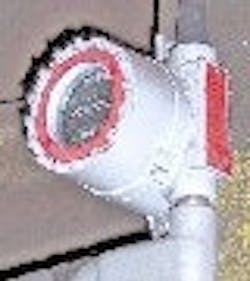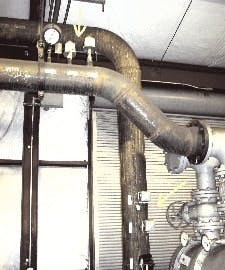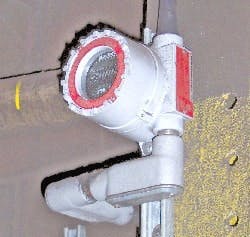Wireless system aids smelter process
THE OHIO is a great river that’s played a major role in U.S. history and commerce. More than most of the nation’s rivers, it’s been used and abused by people and businesses along its banks in recent centuries. In fact, even in its pristine state, it undoubtedly already had plenty of animal, vegetable, and mineral particulate floating along in it. Obvious? Certainly, but it becomes important if you really need that water to be clean.
One of these users is Eramet Marietta Inc., which operates a large ferro manganese smelter near the river in Marietta, Ohio. The plant was built in the 1950s and was bought in 1999 by Paris-based Eramet Comilog Groupe. Eramet is reportedly the world’s largest producer of manganese ferro alloys, which are used to harden and improve the ductile qualities of aluminum and steel.
The Marietta plant’s three furnaces process more than 560,000 metric tons of manganese ore per year, mostly from South Africa, and produces about 180,000 metric tons of manganese ferro alloys. The plant’s special products section also produces chrome and other hardeners. One 30-MW and two 24-MW furnaces use a submerged-arc process that applies electrodes directly to the ore mix to melt it, which removes oxygen, and produces the pure metal. And, of course, it generates lots and lots of heat.
To cool its smelting process, Eramet Marietta historically flushed Ohio River water through sections of the three furnaces. However, the relatively poor quality of the water eventually would clog the plant’s water-cooling pipes and other system components with particles, minerals, and bio-organisms. For example, zebra mussels often grew inside the pipes, and these and other clogs reduced the system’s flow and limited its cooling ability.
“Eventually, the affected cooling pipes and components would fail, and then we’d have a water leak,” says Frank Vallera, Eramet Marietta’s project engineer. “This traditionally meant shutdowns. So, we had to plan on about 7% of the plant’s schedule going to unplanned downtime every year.”
Closing the Loop with Wireless
For many years, Eramet Marietta’s engineers accepted that they couldn’t shoot for more than 93-94% uptime because of the shutdowns needed to clear clogs and repair leaks in its cooling system. However, when the plant’s management approved a project to replace many of the cooling system pipes and devices on the 30-MW furnace, Vallera says they also decided to implement a closed-loop cooling system that would re-circulate clean water. Running at 2,000 gpm from a 14,000-gal. storage tank, the new system picks up heat from the furnace and still uses river water for cooling, but no longer comes in direct contact with it. The plant’s closed-loop cooling system was implemented in 2005 and is expected to reduce shutdowns, increase the furnace’s uptime, and have a much longer life overall than the old cooling system.
The $1.75-million upgrade involved buying new pumps, heat exchangers, filters, a lot of piping, and many other cooling components for the furnace. The closed-loop heat exchange method also required new instrumentation to monitor pressure, temperature, flows, and other aspects of the process water as it picks up heat, gets filtered, and moves back through the system to the furnace. Because they used 24-V, point-to-point hardwiring for other plant systems in the past, Vallera says the engineers knew the new closed-loop system was going to take a huge amount of wiring to connect and monitor all its valves, switches, 110 V solenoids, and other components.
Such pressures often inspire engineers to dream about wireless, but few explore and experiment with it, and even fewer implement it. Vallera says he and his colleagues were intrigued by wireless, however, because Eramet Marietta already had wireless equipment operating in several locations. For example, a couple of the plant’s 12-15 cranes use radio-frequency (RF) controls. Also, the plant’s outgoing truck scale weighs completed product loads and transmits data via a six-year-old, RF-based wireless link to Eramet Marietta’s accounting system.
“These wireless devices might have helped pave the way conceptually for us to investigate using wireless, but, at the time, we also were concerned that existing wireless might interfere with any new wireless we planned to add,” says Vallera. “One of main reasons we chose Accutech for this project was that its devices started to transmit at one frequency range (902 MHz), but then could hop to another frequency (928 Mhz) if they encountered other devices or interference on that initial frequency.”
Wireless transmitter units gather and transmit temperature and pressure data from the closed-loop, water-cooling system at Eramet Marietta.
Site Survey and SetUp
Eramet Marietta’s staff also was encouraged by Accutech’s wireless site survey, which included temporary installation of several remote transmitters (see Figure 1) and a 24-V wireless base unit (see Figure 2 below) to make sure they could find each other, exchange strong signals, and work properly in the plant. The survey also checked that plant buildings, infrastructure, furnaces, machines, and other RF devices didn’t present any interference problems. This also helped Eramet Marietta and Accutech confirm where they should install the permanent base unit and battery-operated transmitters.
Vallera says the furnace’s closed-loop, water-cooling system required 11 wireless instruments screwed into nipples on the piping network, as well as three multi-switch units to handle related 4-20 mA signals. Initial configuration involved little more than turning the units on and pushing a few buttons so the base unit would recognize them. The remote transmitters include five temperature units, three pressure units, one level-indicator, two flowmeters, two multi-input field units, and one switched-input field unit to indicate valve open/closed conditions. He adds that Accutech’s wireless solution cost about $1,200 per unit.
Vallera estimates a hardwired project, which would require building scaffolding, installing conduit, and pulling and terminating the cabling, would have cost about $10,000 per unit to accomplish the same monitoring capabilities. “We saved $45,000-$50,000 just on installation labor and materials,” says Vallera. “And, the monitoring and data we’re getting is just as accurate as if we’d installed a hard-wired system.”
The 24-V base unit with antenna, located in the midst of Eramet Marietta’s three furnaces, wirelessly receives data from its scattered cooling system transmitters.
In addition, because the base station can handle 50 inputs and because the cooling system is only using 14 of them, Vallera says his plant easily can add wireless to the other furnace’s cooling systems. “We’ve already bought the base unit so, if we find another remote location that we want to monitor, we can do it for about $900 per input.”
Likewise, the remote transmitters provide added flexibility because they have a range of up to two miles and have C-sized batteries that can operate for more than five years. Meanwhile, the base unit monitoring cooling of Eramet Marietta’s largest furnace is located no more than 350-400 ft from its furthest remote unit.
Also, the remote units are designed to serve in -40 ºF to 185 ºF settings. However, because ambient temperatures at the plant don’t usually reach more than 100 ºF in summer and only get down to the low teens in winter, Vallaera says no added provision was needed for heating or cooling the units.
Getting to Know You
Though there were some worries that persisted after the wireless monitoring system was installed, Vallera says Eramet Marietta’s users have been encouraged by the fact that the units have worked fine since they were first turned on. “There was a little bit of reluctance early on because people weren’t sure about the wireless network’s reliability and level of support,” says Vallera. “I think much of it was because the folks in field operations initially weren’t familiar with it.”
Vallaera says this situation also was helped by the fact that his colleague, Harold Kidd, used software from Wonderware to develop an HMI that monitors and displays the entire cooling system process for the plant’s operators.
In fact, the level of acceptance has increased so much that Eramet Marietta is planning to wirelessly enable cooling of one of its two 24-MW furnaces in August 2006, and then add wireless to the cooling system of the third furnace in 2007.
“We’re even looking at other processes involving temperature and pressure that we might want to monitor at the plant,” says Vallera. “These might include water pressure and oxygen in the furnace. Someday, we even might actuate changes using the multi-input and switched-output units. We’re not doing it now, but we could look at it in the future.”




